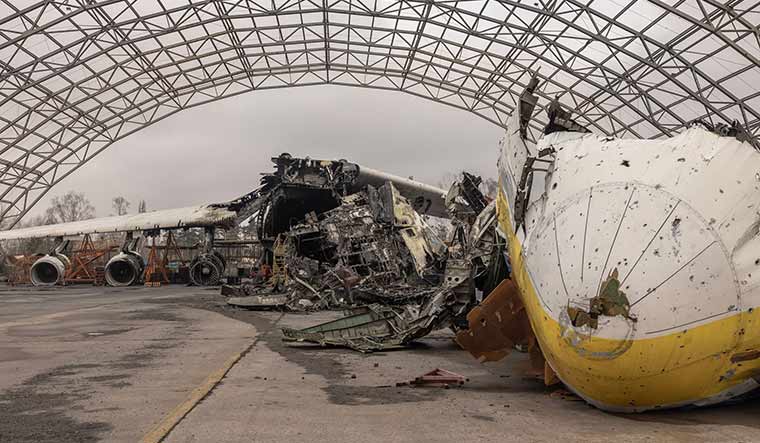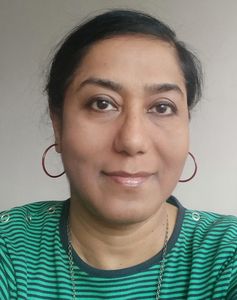AROUND EASTER IN April 2023, on Holocaust Remembrance Day, six-year-old Taras and his mother, Daryna, went to visit his father’s grave, near Hostomel. Taras was holding a small drawing of a big plane, with the words “Mriya never dies” written on them. I joined them. In February 2022, within a few days of Russia’s full-blown invasion against Ukraine, troops were nearing Kyiv. Taras’s father, Yevhen, who worked at the Hostomel airport, succumbed to fatal injuries received during heavy fighting on the outskirts. The world’s largest aircraft, “Mriya”, was housed in Hostomel and it was destroyed in a missile attack. It was symbolic, as mriya in Ukrainian means dream.
Daryna then was in Ternopil in west Ukraine with Taras, and came to know about her husband’s death only weeks later. Shocked and heartbroken, she told Taras that his father was holding the sky up, until it became too heavy for him. Falling, the sky crushed everybody, including “Mriya”. Since then, Taras believes that holding the sky up is the most important thing in this war. It is indeed so.
During February and March 2022, “closing the sky” above Ukraine was the most urgent need of the hour. Multiple campaigns led to no result. Ukraine’s allies faltered in becoming a party to the war and opted to give anti-missile systems instead. Colossal damages not only to military, but also civilian infrastructure, innumerable deaths, injuries, displacement and sufferings of people in places distant from the Russian border are all results of massive air raids.
Geography has been utterly unfair, giving Ukraine a belligerent neighbour with endless appetite for incursions, but history has been no fairer. The truth is that Ukrainians always held the sky up, for the former Soviet Union and the world. However, their contributions to Soviet rocket science, missile and space programmes are denied or are attributed to Russia. Worse, Ukraine’s sky is now open, vulnerable. The air defence guys are blessed by all 24x7, people owe peaceful nights and days to them.
“To hold the sky up” is not intercepting attacking missiles, but something greater and historical for Ukrainians. Records show several pioneers: the first one is Oleksandr Zasyadko of Ukrainian Cossack descent from the Poltava region–whose rockets excelled during the 1877-1878 Russo-Turkish war. The International Astronomical Union named a moon crater after him. Then there is Yuri Kondratyuk, one of the founders of cosmonautics, paving humanity’s way to the moon. His “Kondratyuk track” made in 1916 was used in the American Apollo lunar programme.
And who will deny the leadership of Serhiy Korolyov, from Zhytomyr, Ukraine, director of the Soviet space programme, in launching the first satellite, Sputnik 1, on October 4, 1957, and guiding Yuri Gagarin’s first space flight in 1961, marking the USSR’s first successes? Pavlo Popovich, the fourth human and the first Ukrainian in space, proudly told Nikita Khrushchev in Ukrainian: “I am the first Soviet cosmonaut from Ukraine.”
All these Soviet legacies undeniably owe a big share to Ukraine. Not recognising this is both myopic and colonial. Everything Soviet does not mean Russian.
 A dream, destroyed: The Mriya, after it was hit by Russian missiles | Getty Images
A dream, destroyed: The Mriya, after it was hit by Russian missiles | Getty Images
Independent Ukraine could soon catch up. In 1997, thanks to Leonid Kadenyuk, who spent 15 days and 16 hours in space on the US space shuttle Columbia, the flag of Ukraine was raised and the anthem played in space for the first time. From 2006 to 2008, Heidemarie Martha Stefanyshyn-Piper―a NASA astronaut and woman of Ukrainian origin―made five spacewalks totalling 33 hours and 42 minutes.
Not only persons, institutions matter as well. Daryna, herself an aviation engineer, says it is hard to believe that the Ukrainian aerospace industry that started as early as 1954, founding the world’s best companies in Dnipropetrovsk (now Dnipro), has to beg the world today for air defence. Ukrainian giants such as the Yuzhnoye State Design Office and the Yuzhmash Machine-Building Plant (now the Pivdenniy Machine-Building Plant) produced countless ballistic and space rockets, rocket engines, satellites, and world famous Ukraine-designed Zenit and Cyclone booster rockets. Since 1991, over 160 rockets and more than 370 spacecraft were launched with the participation of Ukraine, including Vega and Antares.
Ukraine is one of the few countries in the world that has a closed rocket production cycle, ranging from rocket fuel to airframes, launch vehicles and spacecraft. No wonder why president A.P.J. Abdul Kalam, who spoke highly of Ukraine’s rocket and space science contributions, took a trip to these institutions in Dnipro during his state visit in 2005. It is also no surprise that Elon Musk calls Zenit the best launch vehicle in the world after his Falcon. Just before the war in 2022, Space X launched the second-ever Ukrainian satellite, Sich 2.
War has put Ukraine on the brink, but people who hold up the sky never give up. Pivdenmash aspires to create a floating spaceport in the Kherson region, now partly occupied by Russia. Yuzhnoye’s dream is to set up a permanent base on the moon’s surface. Mriya, the dream, never dies.
Most aerospace enterprises continue to work and collect aid for the Ukrainians and the army. “With a fast-track entry into the European Union, Ukraine will develop the space industry in a couple of years,” says Daryna. “Let the war end. I need to get a kilo of coffee for the air defence guys, my husband’s friends. They stay awake 24/7 and let us have peaceful nights.”
Meanwhile, for Taras, the big news is: Mriya, the largest bird, will be reconstructed. While Russian missiles rain death on Ukrainians, he thinks his deceased dad and others are called by God to help hold up the sky. Bidding me goodbye, he says, “You should love your people, land and the sky more. More than you ever could. Then “Mriya” will never die.”
Mridula Ghosh formerly with the UN, is now based in Kyiv, teaching at the National University of Kyiv-Mohyla Academy, and also leads an NGO.



